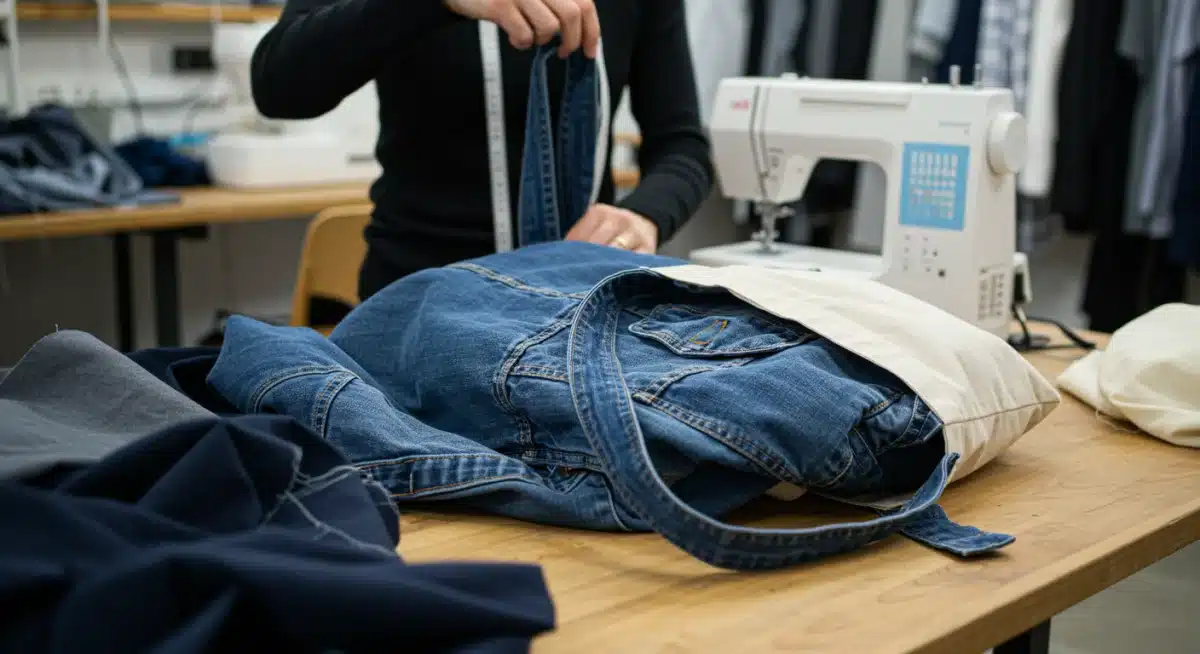Wardrobe Refresh: Donate, Sell, or Repurpose for 2025 Impact

Advertisement
A successful wardrobe refresh for 2025 necessitates a clear strategy for deciding whether to donate, sell, or repurpose clothing, ensuring both personal style enhancement and community benefit.
Embarking on a wardrobe refresh 2025 is more than just tidying up your closet; it’s an opportunity to redefine your style, embrace sustainability, and contribute positively to your community. This guide will walk you through the essential strategies for decluttering your wardrobe, making informed decisions on what to keep, donate, sell, or repurpose, and ultimately achieving a more organized and impactful closet.
Advertisement
Understanding the Need for a Wardrobe Refresh
A wardrobe refresh is an essential practice for anyone looking to maintain a functional and stylish closet. Over time, clothes accumulate, styles change, and our personal preferences evolve. Without regular maintenance, our wardrobes can become cluttered, making it difficult to find what we need and leading to unnecessary purchases.
Beyond personal convenience, a conscious wardrobe refresh aligns with broader sustainability goals. Fast fashion has significant environmental impacts, from excessive water use to textile waste. By thoughtfully decluttering and giving new life to our garments, we participate in a more circular economy, reducing our ecological footprint.
The Evolution of Personal Style
Our personal style is not static; it grows and changes with us. What appealed to us a few years ago might not resonate today. A wardrobe refresh allows us to shed items that no longer reflect our current aesthetic or lifestyle, making space for pieces that genuinely express who we are now.
Advertisement
- Reflect on current fashion trends and how they align with your taste.
- Consider your daily activities and ensure your wardrobe supports them.
- Identify pieces that no longer fit comfortably or flatter your figure.
Environmental Impact of Clothing Waste
The fashion industry is a major contributor to global pollution. Landfills are overflowing with discarded textiles, many of which could have been reused or recycled. A proactive approach to decluttering helps mitigate this issue by diverting clothes from waste streams and extending their lifespan.
Every item we keep out of a landfill makes a difference. This awareness transforms a simple closet clean-out into an act of environmental stewardship. It encourages us to think critically about our consumption habits and to make more mindful choices moving forward.
Ultimately, understanding the multifaceted benefits of a wardrobe refresh—from personal organization to global environmental responsibility—provides the motivation needed to undertake this task with intention and purpose. It’s an investment in a more sustainable future and a more authentic personal style.
The Decluttering Process: A Step-by-Step Guide
Approaching a wardrobe refresh systematically can make the task less daunting and more effective. Before making any decisions about donating, selling, or repurposing, it’s crucial to go through a thorough decluttering process. This involves emptying your closet, assessing each item, and making initial sorting decisions.
Start by dedicating a significant block of time to this activity, ensuring you won’t be rushed. Gather all your clothes, shoes, and accessories in one place, ideally on your bed or a large clear surface. This visual overview helps you grasp the true volume of your wardrobe.
Emptying and Assessing Your Wardrobe
The first step is to remove everything from your closet and drawers. This might seem extreme, but it provides a clean slate and allows you to see every single item you own. As you pick up each piece, ask yourself a series of critical questions to determine its fate.
Consider the emotional connection you have with an item. Does it bring you joy? Does it hold sentimental value? While sentiment is important, it shouldn’t overshadow practicality. Balance emotional attachment with functionality and current relevance.
Key Questions for Each Item
To make informed decisions, apply a consistent set of questions to every piece of clothing. This structured approach helps eliminate indecision and ensures a comprehensive review of your wardrobe.
- Have I worn this in the last year? If not, why?
- Does it fit me well and comfortably?
- Is it in good condition (no stains, rips, or excessive wear)?
- Does it align with my current style and lifestyle?
- Do I feel confident and good when I wear it?
Creating Sorting Piles
Once you’ve assessed each item, create distinct piles. These initial piles will guide your subsequent decisions regarding donation, sale, or repurposing. Be disciplined in adhering to these categories to avoid re-cluttering.
Common piles include ‘Keep,’ ‘Donate,’ ‘Sell,’ and ‘Repurpose.’ A ‘Maybe’ pile can be useful for truly difficult decisions, but try to keep it small and revisit it with fresh eyes later. The goal is to minimize the ‘Keep’ pile to only items you truly love and wear.
This systematic decluttering phase is the foundation of a successful wardrobe refresh 2025. It sets the stage for conscious choices that will result in a more organized, sustainable, and personally fulfilling closet.
Donating Clothes: Making a Positive Impact
Donating clothes is a powerful way to give back to the community and extend the life cycle of your garments. When done thoughtfully, it ensures that your gently used items can benefit others who are in need, preventing them from ending up in landfills.
Choosing the right charity or organization is crucial for ensuring your donations serve their intended purpose. Research local options and understand their specific needs and collection policies. This ensures your efforts are truly impactful.

Finding Reputable Donation Centers
Not all donation centers are created equal. Some focus on specific demographics, like homeless shelters or organizations supporting job seekers, while others have broader missions. Knowing where your clothes are going can provide a sense of satisfaction and ensure they reach the right hands.
Local churches, community centers, and well-known charities often accept clothing donations. Websites like Goodwill, Salvation Army, and smaller local non-profits are excellent starting points. Always check their websites or call ahead for current donation guidelines and hours of operation.
Preparing Items for Donation
To maximize the impact of your donation, present items in the best possible condition. Clean clothes are more likely to be used and appreciated. A little effort on your part can make a significant difference in how your donation is received and utilized.
- Wash all clothing items thoroughly.
- Repair minor issues like loose buttons or small tears.
- Fold or hang items neatly before dropping them off.
- Separate items by type if the charity requests it.
Benefits of Donating
Beyond helping those in need, donating clothes offers several other advantages. It declutters your home, reduces textile waste, and can even offer tax benefits. Many organizations provide receipts for tax purposes, allowing you to itemize charitable contributions.
Donating fosters a sense of community and social responsibility. It’s a tangible way to contribute to a more equitable society and to promote sustainable consumption practices. This act of giving is a cornerstone of a truly meaningful wardrobe refresh 2025.
By carefully selecting where and how you donate, you ensure that your unwanted clothes find a second life, benefiting both people and the planet. It is a simple yet profound gesture of kindness and environmental consciousness.
Selling Clothes: Earning Back and Recycling Fashion
Selling your gently used clothes is an excellent way to recoup some of your initial investment while contributing to the circular fashion economy. It allows items that are still fashionable and in good condition to find a new owner, reducing waste and promoting sustainable consumption.
The market for pre-owned clothing has grown significantly, thanks to various online platforms and local consignment shops. Understanding these avenues can help you choose the best option for your items and maximize your earnings.
Online Marketplaces and Apps
Online platforms have revolutionized how we sell used clothing. They offer a wide reach and convenience, allowing you to list items from the comfort of your home. Each platform has its own fee structure, audience, and listing process, so it’s worth exploring a few to find the best fit.
Popular options like Poshmark, Depop, eBay, and ThredUp cater to different styles and price points. Poshmark and Depop are great for individual sellers looking to list specific items, while ThredUp offers a consignment service where they handle the selling for you.
Consignment Stores and Local Boutiques
For those who prefer a more hands-off approach or want to support local businesses, consignment stores and local boutiques are excellent choices. These stores typically take a percentage of the sale price, but they handle all the marketing and customer interactions.
- Research local consignment shops known for accepting quality items.
- Understand their commission rates and payout schedules.
- Ensure your items meet their specific brand and condition requirements.
- Consider boutiques that specialize in certain styles, like vintage or designer wear.
Pricing and Photography Tips
To successfully sell your clothes, attractive listings are key. High-quality photos and competitive pricing will draw more buyers. Think about how you would want to see an item presented if you were the buyer.
Use natural light for your photos, show the item from multiple angles, and highlight any unique details or features. For pricing, research similar items on the platform you’re using. Be realistic about the value of used clothing, but don’t undervalue quality pieces.
Selling clothing is not just about making money; it’s about giving garments a second life and promoting a more sustainable approach to fashion. It’s an integral part of a comprehensive wardrobe refresh 2025, allowing you to refresh your closet and your wallet simultaneously.
Repurposing Clothes: Unleashing Creativity and Sustainability
Repurposing clothes is perhaps the most creative and environmentally friendly option for items that can’t be donated or sold. It involves transforming old, worn-out, or ill-fitting garments into something new and functional, extending their lifespan and preventing textile waste.
This approach taps into your creativity, allowing you to see potential in what others might consider trash. From simple alterations to complete transformations, repurposing offers endless possibilities for sustainable fashion and home decor.
Simple Alterations and Upgrades
Not every item needs a complete overhaul. Sometimes, a small alteration can breathe new life into a garment. This could be as simple as hemming pants, taking in a dress, or adding embellishments. These small changes can make an item feel brand new and perfectly suited to your current style.
Consider dyeing faded clothes a new color or adding patches to cover small stains or holes. These minor upgrades require minimal skill but can significantly enhance the wearability and aesthetic appeal of an item you were ready to discard.
Craft Projects and DIY Transformations
For those with a penchant for crafting, old clothes are a treasure trove of raw materials. T-shirts can become tote bags, denim jeans can be transformed into shorts or skirts, and sweaters can be repurposed into cozy pillows or pet beds. The internet is full of tutorials and inspiration for DIY clothing transformations.

This approach is particularly rewarding because you end up with a unique, custom-made item that reflects your personal touch. It’s a fantastic way to engage in sustainable practices while developing new skills and creating something truly original.
Repurposing for Home and Family
Beyond personal fashion, old clothes can find new life around the house or for other family members. Soft cotton t-shirts make excellent cleaning rags, old towels can become pet blankets, and even socks can be turned into dust mitts or puppets for children.
- Turn old blankets or sweaters into pet bedding.
- Create patchwork quilts from sentimental clothing scraps.
- Use denim scraps for practical items like coasters or storage bins.
- Transform baby clothes into keepsake items or decorative garlands.
Repurposing is a testament to the idea that waste is a design flaw. By embracing this mindset, you not only reduce your environmental impact but also foster a more creative and resourceful lifestyle. It’s an integral and imaginative component of a comprehensive wardrobe refresh 2025.
Maintaining Your Refreshed Wardrobe in 2025
A successful wardrobe refresh isn’t a one-time event; it’s an ongoing commitment to mindful consumption and organization. Once you’ve decluttered and made decisions about your old clothes, the next step is to establish habits that keep your wardrobe streamlined and sustainable throughout 2025 and beyond.
This involves adopting new organizational strategies, practicing conscious shopping, and regularly reviewing your closet to prevent clutter from accumulating again. Consistency is key to long-term success.
Implementing Organizational Systems
Once your wardrobe is pared down, implement organizational systems that work for your space and lifestyle. This could involve using drawer dividers, matching hangers, or clear storage bins. The goal is to make every item visible and easily accessible.
Categorize your clothes by type, season, or occasion. This not only saves time when getting dressed but also helps you identify gaps in your wardrobe or areas where you might still have too many similar items. A well-organized closet encourages mindful usage.
Conscious Shopping Habits
The most effective way to maintain a refreshed wardrobe is to change your shopping habits. Before making a new purchase, ask yourself if you truly need the item, if it aligns with your existing wardrobe, and if it’s a quality piece that will last. Prioritize versatile items.
Embrace sustainable shopping practices, such as buying second-hand, supporting ethical brands, or investing in timeless pieces rather than fleeting trends. This reduces the influx of new items and supports a more responsible fashion industry.
Regular Wardrobe Reviews
Schedule periodic mini-refreshes throughout the year. A quick review at the change of seasons, for example, can help you assess what you’ve worn, what still fits, and what might be ready for its next chapter. This prevents the overwhelming accumulation that often leads to major decluttering sessions.
- Conduct a small review every three to six months.
- Identify items that have gone unworn or are showing significant wear.
- Re-evaluate if items still align with your style and needs.
- Address minor organizational issues before they become major problems.
By integrating these practices into your routine, your wardrobe refresh 2025 becomes a sustainable lifestyle choice rather than a one-off chore. You’ll enjoy a functional, stylish, and environmentally conscious closet year-round.
The Broader Impact: Sustainability and Community
The act of decluttering and thoughtfully managing your wardrobe extends far beyond personal benefits. It contributes significantly to broader goals of environmental sustainability and community support. Every decision to donate, sell, or repurpose creates a ripple effect, fostering a more responsible and interconnected society.
Embracing these practices means actively participating in a movement towards a more circular economy, where resources are valued and waste is minimized. It’s a powerful statement about conscious living and the positive change individuals can initiate.
Reducing Textile Waste
One of the most immediate and tangible impacts of a well-executed wardrobe refresh 2025 is the reduction of textile waste. The fashion industry generates an enormous amount of waste annually, much of which could be avoided through reuse and recycling. By giving your clothes a second life, you directly divert them from landfills.
This reduction in waste lessens the burden on our planet’s resources, decreases pollution associated with textile production and disposal, and conserves valuable landfill space. It’s a critical step in mitigating the environmental footprint of fashion.
Supporting Circular Economy Principles
The circular economy aims to keep products and materials in use for as long as possible, extracting the maximum value from them while in use, then recovering and regenerating products and materials at the end of each service life. Donating, selling, and repurposing are all key pillars of this economic model.
By engaging in these activities, you become an active participant in a system that prioritizes longevity, reuse, and regeneration over the traditional linear ‘take-make-dispose’ model. This shift is vital for building a more sustainable future for fashion and other industries.
Community Empowerment and Social Responsibility
Donating clothes to charities directly benefits individuals and families in need, providing them with essential items they might not otherwise afford. This act of generosity strengthens community bonds and supports vulnerable populations, fostering a sense of shared responsibility.
- Provides affordable clothing options for low-income families.
- Supports job training programs through thrift stores.
- Offers clothing to individuals re-entering the workforce.
- Reduces financial strain on families facing economic hardship.
Moreover, choosing to sell clothes on platforms that support small businesses or local consignment shops can also contribute to local economies. The collective impact of these individual actions creates a more resilient and compassionate society.
Ultimately, a mindful wardrobe refresh is far more than a personal endeavor; it’s a commitment to a more sustainable planet and a more supportive community. It embodies the spirit of conscious consumption and responsible living for 2025 and beyond.
| Action | Description & Benefit |
|---|---|
| Donate | Give gently used items to charities; supports community, reduces waste, potential tax benefits. |
| Sell | Recoup costs for quality items via online marketplaces or consignment; promotes circular fashion. |
| Repurpose | Transform old clothes into new items or for other uses; maximizes creativity and sustainability. |
| Maintain | Implement organizational systems and conscious shopping habits for lasting wardrobe health. |
Frequently Asked Questions About Wardrobe Refresh
The best time for a wardrobe refresh is typically at the change of seasons. Spring and fall are ideal as you transition between warm and cold weather clothing, allowing you to assess items for current relevance and condition effectively.
Items in excellent condition, still fashionable, or from desirable brands are good candidates for selling. Those gently used but not meeting high resale standards are best for donation. Consider the item’s potential market value versus its charitable impact.
Old clothes can become cleaning rags, pet bedding, tote bags, or even unique craft projects like patchwork quilts. Denim can be turned into shorts or skirts, while t-shirts can be braided into rugs. The possibilities are vast for imaginative transformations.
To avoid re-cluttering, adopt a ‘one in, one out’ policy: for every new item you buy, remove an old one. Practice conscious shopping, invest in quality over quantity, and conduct mini-reviews of your wardrobe regularly to stay organized.
Yes, if you itemize deductions, you can often claim the fair market value of donated clothing to qualified charitable organizations. Always get a receipt from the charity for your records. Consult a tax professional for specific advice.
Conclusion
Undertaking a wardrobe refresh 2025 is a multifaceted endeavor that transcends mere organization. It’s a strategic process that empowers you to refine your personal style, embrace sustainable living, and make a tangible difference in your community. By thoughtfully deciding whether to donate, sell, or repurpose your clothes, you participate in a more circular economy, reducing textile waste and extending the life of garments. This conscious approach not only leads to a more functional and aesthetically pleasing closet but also fosters a deeper connection to environmental stewardship and social responsibility. As you move forward, integrating regular reviews and conscious shopping habits will ensure your refreshed wardrobe remains a source of joy and positive impact, embodying a truly sustainable lifestyle for years to come.





